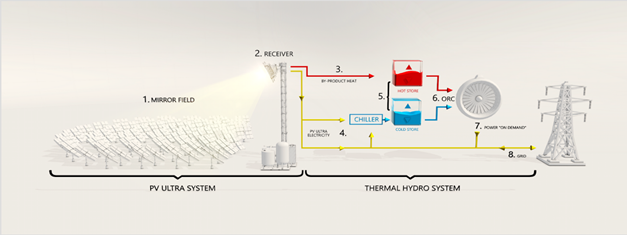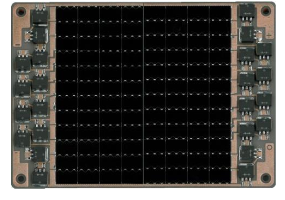
Published
by Stefan Lutter – Manager Product Management, AES
Advanced Electronics Solutions
Can Rogers support a global energy transition to renewables? With increasingly severe weather disasters and the impact of the Ukraine-Russia conflict, many countries are looking for alternative forms of energy. Solar energy is sufficiently available in many parts of the world, but it is not necessarily available at the right times. A lot of thinking goes into photovoltaic systems, how to store generated energy and how to generate more energy using smaller and smaller areas. In this blog, we present two possible solutions that could be used to support renewables better in the future.
Concentrated Photovoltaics (CPV)
Unlike conventional photovoltaic systems, lenses and curved mirrors are used to focus sunlight onto small but highly efficient multi-junction solar cells (MJ). CPV systems often use solar tracking systems and sometimes a cooling system to further increase their efficiency. Systems with highly concentrated photovoltaics (HCPV) could become competitive soon. They have the highest efficiency of all existing PV technologies, and a smaller photovoltaic system also reduces the balance of system costs. Currently, CPV is not used in the rooftop PV segment and is far less common than conventional PV systems. Modern CPV systems work most efficiently in highly concentrated sunlight (i.e. concentrations equivalent to hundreds of suns), if the solar cell is kept cool using heat sinks. To help enable the growth of these systems, Rogers has the potential to support with bare copper or insolated micro-channel heat sinks.
Figure 1: The Raygen Solar power plant
Thermo-photovoltaics (TPV)
Like in solar energy generation by solar cells, in thermo-photovoltaics the radiant energy is converted into electricity. Unlike solar cells, however, the radiant energy does not come from the sun but is emitted in the form of thermal radiation (long-wave photons) from a hot emitter. Special thermo-photovoltaic cells made of absorber materials with band gaps in the infrared range can efficiently convert this thermal radiation into electrical power. In an energy system based on fluctuating renewable energy sources, thermo-photovoltaic systems can play an important role in storing excess electrical energy. This can be stored in the form of heat at high temperature and can be converted back to electricity when needed using thermo-photovoltaic modules.1
Figure 2: Schematic conceptual layout of a utility-scale TPV system.
Why can Roger’s micro channel cold plates support this change?
Rogers curamik® Cooling Solutions offer a suite of advanced liquid cooling solutions powered by the state of the art curamik® bonding process. Layers are hermetically combined without any additional soldering or adhesive. These innovative liquid coolers feature copper foil channel structures (<250 micrometer channel width) that are bonded into a tight block using the curamik® process. Compared to standard solutions, Rogers coolers can be four times more efficient than traditional liquid cooling module structures. The narrow channels bring more highly conductive copper surface area to the cooling medium than many other solutions. This is the secret of Rogers coolers´ performance. If necessary, coolers can be integrated with ceramic substrates, enabling direct component assembly and electrical isolation from the cooling circuit.
Figure 3: CPV Dense Array Module
Do you have any question or require some information about our coolers? Please contact us, if you need assistance.
Tags:
Olivier's Twist Blog
Published on Sep 16, 2022


